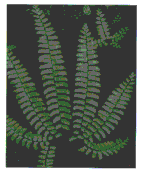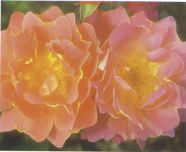John Ray and the Treasures of Nature
by John Hudson Tiner, House Springs, Missouri
John Ray learned about plants from his mother who made herbal remedies
for sick neighbors. He proved to have a sharp mind with a strong
interest in science. He won a scholarship to Cambridge. After
graduation in 1648, University officials asked him to stay on as a
lecturer. Cambridge was a pleasant place. The college provided him with
an apartment, and students cooked his meals and delivered them to his
door. The college gave him a plot of land near the main gate for
planting a garden. In addition to his scientific duties, John Ray
became a clergyman in the Church of England. He often gave the daily
devotion during the chapel service at Cambridge.
 The study of plants became John Ray's passion. On the
long summer
days, he explored the countryside around Cambridge. His garden became a
living museum of interesting plant specimens. The number of plants
became so great he could not easily comprehend all he learned about
them. He needed some method to classify them. What was true of one
plant in a class was true of all plants in the class. Ray searched for
a natural system of classification that would reflect the order given
by God when he created plants and animals. He noticed that some plants
produced flowers. Others did not. Flowering plants were one division.
Some flowering plants had single seed leaves. Others had double seed
leaves. This separated the flowering division into two distinct
classes. His thoughts on classification were interrupted by political
turmoil at Cambridge. The new King Charles II insisted that all college
professors sign a document that renounced the religious ideas of Oliver
Cromwell, the previous ruler. "Sign or be dismissed from your post at
Cambridge," officials told him.
The study of plants became John Ray's passion. On the
long summer
days, he explored the countryside around Cambridge. His garden became a
living museum of interesting plant specimens. The number of plants
became so great he could not easily comprehend all he learned about
them. He needed some method to classify them. What was true of one
plant in a class was true of all plants in the class. Ray searched for
a natural system of classification that would reflect the order given
by God when he created plants and animals. He noticed that some plants
produced flowers. Others did not. Flowering plants were one division.
Some flowering plants had single seed leaves. Others had double seed
leaves. This separated the flowering division into two distinct
classes. His thoughts on classification were interrupted by political
turmoil at Cambridge. The new King Charles II insisted that all college
professors sign a document that renounced the religious ideas of Oliver
Cromwell, the previous ruler. "Sign or be dismissed from your post at
Cambridge," officials told him.
John Ray did not take lightly his Christian beliefs. He refused to
sign. In 1662, he was dismissed from his post, lost his home and
salary. He could not use the college library. His garden had 700 plants
that he worked on for 10 years. It grew on school property. He lost it,
too.
 Without the duties of teaching, he would have time to
see more of
nature. He told his friends, "I have always wanted to explore England.
I shall make an effort to extend my plant studies to include all of
England." He had time but no money. He trusted that God would provide.
Sir Francis Willughby, a former student, suggested that John Ray lead a
tour of England. Sir Francis and a friend would go with John Ray and
pay all of his expenses.
Without the duties of teaching, he would have time to
see more of
nature. He told his friends, "I have always wanted to explore England.
I shall make an effort to extend my plant studies to include all of
England." He had time but no money. He trusted that God would provide.
Sir Francis Willughby, a former student, suggested that John Ray lead a
tour of England. Sir Francis and a friend would go with John Ray and
pay all of his expenses.
Exploring England at that time was not as simple as one might
suppose. No maps had been made showing the trails and roads in the
country. Although heroic navigators had sailed across the ocean to the
New World, most would have quickly become lost in the bewildering back
roads of England. John Ray was the first person to thoroughly explore
England, Scotland, and Wales.
In 1667, he published Catalogue
of British Plants. Often professors made their books difficult
to understand to prove how smart they were. Not John Ray. He wrote to
reveal nature and show the sense of wonder in God's creation. His book
was noted for its accurate descriptions. Ray urged people to send
corrections and samples of plants he had not described. He said, "The
bounds of science are not fixed. The treasures of nature are
inexhaustible."
By 1685, a persistent infection in his legs prevented him from long
travels. He turned to a study of insects in his own backyard. One day
he watched as a wasp dragged a green caterpillar three times larger
than itself. It pulled the caterpillar to the mouth of a burrow that it
had previously dug. It removed a ball of earth that sealed the entrance
and went down into the hole. After a brief stay, the wasp came up
again. Seizing the caterpillar, the wasp carried it down into the
burrow. Carefully the wasp filled in the hole. Ray asked, "Who would
not wonder in amazement at this?"
He wrote a book titled Wisdom of
God Manifested in the Works of the Creation. The book gave
evidences from the nature of God's wisdom and power. Unfortunately, it
was not published for many years because John Ray's religious writings
were banned. Printers faced heavy fines if they printed his religious
books. This changed after William and Mary became joint rulers of
England in 1689. For the first time in 30 years, John Ray could find a
printer for his religious books.
By 1705, he had written 22 books about nature and religious
subjects. He saw his life ending. He provided for his family and gave
his nature collections to one of his students. He sent money to
Cambridge to buy books for the library--the same library that had been
closed to him for 30 years.
Today, John Ray is called one of the founders of modern botany. What
did he think of his work? John Ray said, "I predict that our
descendants will reach such heights in the sciences that our noblest
discoveries will seem slight, obvious and almost worthless." Of course,
his work has proven to be far from worthless. His books are still read
today. Scientists marvel at the precision with which he wrote and his
evident enthusiasm for his subject.
Back to Contents
Does God Exist?, NovDec04.
 The study of plants became John Ray's passion. On the
long summer
days, he explored the countryside around Cambridge. His garden became a
living museum of interesting plant specimens. The number of plants
became so great he could not easily comprehend all he learned about
them. He needed some method to classify them. What was true of one
plant in a class was true of all plants in the class. Ray searched for
a natural system of classification that would reflect the order given
by God when he created plants and animals. He noticed that some plants
produced flowers. Others did not. Flowering plants were one division.
Some flowering plants had single seed leaves. Others had double seed
leaves. This separated the flowering division into two distinct
classes. His thoughts on classification were interrupted by political
turmoil at Cambridge. The new King Charles II insisted that all college
professors sign a document that renounced the religious ideas of Oliver
Cromwell, the previous ruler. "Sign or be dismissed from your post at
Cambridge," officials told him.
The study of plants became John Ray's passion. On the
long summer
days, he explored the countryside around Cambridge. His garden became a
living museum of interesting plant specimens. The number of plants
became so great he could not easily comprehend all he learned about
them. He needed some method to classify them. What was true of one
plant in a class was true of all plants in the class. Ray searched for
a natural system of classification that would reflect the order given
by God when he created plants and animals. He noticed that some plants
produced flowers. Others did not. Flowering plants were one division.
Some flowering plants had single seed leaves. Others had double seed
leaves. This separated the flowering division into two distinct
classes. His thoughts on classification were interrupted by political
turmoil at Cambridge. The new King Charles II insisted that all college
professors sign a document that renounced the religious ideas of Oliver
Cromwell, the previous ruler. "Sign or be dismissed from your post at
Cambridge," officials told him. Without the duties of teaching, he would have time to
see more of
nature. He told his friends, "I have always wanted to explore England.
I shall make an effort to extend my plant studies to include all of
England." He had time but no money. He trusted that God would provide.
Sir Francis Willughby, a former student, suggested that John Ray lead a
tour of England. Sir Francis and a friend would go with John Ray and
pay all of his expenses.
Without the duties of teaching, he would have time to
see more of
nature. He told his friends, "I have always wanted to explore England.
I shall make an effort to extend my plant studies to include all of
England." He had time but no money. He trusted that God would provide.
Sir Francis Willughby, a former student, suggested that John Ray lead a
tour of England. Sir Francis and a friend would go with John Ray and
pay all of his expenses.